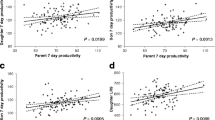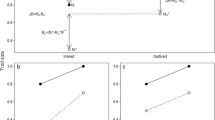Abstract
Here we present results of a Drosophila long term experiment where we study the fitness consequences of equating the number of breeding offspring contributed per family (EC) compared to a random contribution (RC) protocol. The EC strategy slows inbreeding and drift. However, it also prevents natural selection on fecundity and limits selection on viability to that occurring within families, and this includes purge against unconditionally deleterious alleles as well as adaptation to captive conditions. We used populations maintained with 5 or 25 single mated pairs, monitored inbreeding and selection intensity, and assayed competitive and non competitive fitness, as well as fecundity and viability components, in lines maintained with or without EC. In the small lines, EC showed modest advantage for viability during the whole experiment and for fitness up to generation 15 while, in the large lines, fitness increased steadily under both strategies, and EC led in the medium term to a slight fitness disadvantage. On the light of recent theory, these results can be explained as the joint consequence of new and standing deleterious mutations undergoing drift, inbreeding and selection and of adaptation to captive conditions.




Similar content being viewed by others
References
Allendorf FW (1993) Delay of adaptation to captive breeding by equalizing family size. Conserv Biol 7:416–419
Amador C, García-Dorado A, Bersabé D, López-Fanjul C (2010) Regeneration of the variance of metric traits by spontaneous mutation in a Drosophila population. Genet Res 92:91–102
Ávila V, García-Dorado A (2002) The effects of spontaneous mutation on competitive fitness in Drosophila melanogaster. J Evol Biol 15:561–566
Borlase SC, Loebel DA, Frankham R, Nurthen RK, Briscoe DA, Daggard GE (1993) Modeling problems in conservation genetics using captive Drosophila populations: consequences of equalization of family sizes. Conserv Biol 7:122–131
Bryant EH, Reed DH (1999) Fitness decline under relaxed selection in captive populations. Conserv Biol 13:665–669
Caballero A, Toro MA (2000) Interrelations between effective population size and other pedigree tools for the management of conserved populations. Genet Res Camb 75:331–343
Falconer DS, Mackay TFC (1996) Introducción a la genética cuantitativa. Acribia, Zaragoza (España)
Fernández J, Caballero A (2001) Accumulation of deleterious mutations and equalization of parental contributions in the conservation of genetic resources. Heredity 86:480–488
Fernández J, Toro MA, Caballero A (2004) Managing individuals’ contributions to maximize the allelic diversity maintained in small, conserved populations. Conserv Biol 18:1358–1367
Frankham R, Manning H, Margan SH, Briscoe DA (2000) Does equalization of family sizes reduce genetic adaptation to captivity? Anim Conserv 4:357–363
Frankham R, Ballou JD, Briscoe DA (2002) Introduction to conservation genetics. Cambridge University Press, Cambridge, New York, New York, USA
García-Dorado A (1997) The rate and effects distribution of viability mutations in Drosophila: minimum distance estimation. Evolution 51:1130–1139
García-Dorado A (2003) Tolerant versus sensitive genomes: the impact of deleterious mutations on fitness and conservation. Conserv Genet 4:311–324
García-Dorado A (2007) Shortcut predictions for fitness properties at the mutation–selection–drift balance and for its buildup after size reduction under different management strategies. Genetics 176:983–997
García-Dorado A (2008) A simple method to account for natural selection when predicting inbreeding depression. Genetics 180:1559–1566
García-Dorado A, Caballero A (2002) The mutational rate of Drosophila viability decline: tinkering with old data. Genet Res 80:99–105
García-Dorado A, López-Fanjul C, Caballero A (1999) Properties of spontaneous mutations affecting quantitative traits. Genet Res 74:47–51
García-Dorado A, López-Fanjul C, Caballero A (2004) Rates and effects of deleterious mutations and their evolutionary consequences. In: Moya A, Font E (eds) Evolution: from molecules to ecosystems. Oxford University Press, Oxford, pp 20–32
Gilligan DM, Frankham R (2003) Dynamics of genetic adaptation to captivity. Conserv Genet 4:189–197
Halligan DL, Keightley PD (2009) Spontaneous mutation accumulation studies in evolutionary genetics. Ann Rev Ecol Syst 40:151–172
Hill WG, Caballero A, Dempfle L (1996) Prediction of response to selection within families. Genet Sel Evol 28:379–383
Keightley PD (1996) Nature of deleterious mutation load in Drosophila. Genetics 144:1993–1999
Keightley PD, Caballero A, García-Dorado A (1998) Surviving under mutation pressure. Curr Biol 8:R235–R237
Latter BDH, Mulley JC (1995) Genetic adaptation to captivity and inbreeding depression in small laboratory populations of Drosophila melanogaster. Genetics 139:255–266
Lynch M, Blanchard J, Houle D, Kibota T, Schulz S, Vassilieva L, Willis J (1999) Perspective: spontaneous deleterious mutation. Evolution 53:645–663
Mukai T (1964) The genetic structure of natural populations of Drosophila melanogaster. I. Spontaneous mutation rate of polygenes controlling viability. Genetics 50:1–19
Mukai T, Chigusa SI, Mettler EM, Crow JF (1972) Mutation rate and dominance of genes affecting viability in Drosophila melanogaster. Genetics 72:333–355
Pérez-Figueroa A, Caballero A, García-Dorado A, López-Fanjul C (2009) The action of purifying selection, mutation and drift on fitness epistatic systems. Genetics 183:299–313
Rodriguez-Ramilo ST, Morán P, Caballero A (2006) Relaxation of selection with equalization of parental contributions in conservation programs: an experimental test with Drosophila melanogaster. Genetics 172:1043–1054
Rodríguez-Ramilo ST, Pérez-Figueroa A, Fernández B, Fernández J, Caballero A (2004) Mutation-selection balance accounting for genetic variation for viability in Drosophila melanogaster as deduced from an inbreeding and artificial selection experiment. J Evol Biol 17:528–541
Schoen DJ, David JL, Bataillon TM (1998) Deleterious mutation accumulation and the regeneration of genetic resources. Proc Natl Acad Sci USA 95:394–399
Shabalina SA, Yampolsky LY, Kondrashov AS (1997) Rapid decline of fitness in panmictic populations of Drosophila melanogaster maintained under relaxed natural selection. Proc Natl Acad Sci USA 94:13034–13039
Theodorou K, Couvet D (2003) Familial versus mass selection in small populations. Genet Sel Evol 35:425–444
Wang J, Hill WG (2000) Marker assisted selection to increase effective population size by reducing mendelian segregation variance. Genetics 154:475–489
Welch BL (1947) The generalization of Student’s problem when several different population variances are involved. Biometrika 34:28–35
Woodworth LM, Montgomery ME, Briscoe DA, Frankham R (2002) Rapid genetic deterioration in captive populations: causes and conservation implications. Conserv Genet 3:277–288
Wright S (1938) Size of population and breeding structure in relation to evolution. Science 87:430–431
Acknowledgments
We are grateful to Carlos López-Fanjul for useful discussion and to Mauro Santos for providing the original Drosophila sample. This work was supported by grants CGL2008-02343/BOS from the Ministerio de Ciencia e Innovación and UCM-BSCH GR58/08-910433 from the Universidad Complutense.
Author information
Authors and Affiliations
Corresponding author
Rights and permissions
About this article
Cite this article
Sánchez-Molano, E., García-Dorado, A. The consequences on fitness of equating family contributions: inferences from a drosophila experiment. Conserv Genet 12, 343–353 (2011). https://doi.org/10.1007/s10592-010-0143-3
Received:
Accepted:
Published:
Issue Date:
DOI: https://doi.org/10.1007/s10592-010-0143-3




